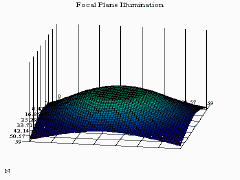Animated focal plane illumination map |
| by Bryan Greer |
| Originally posted Feb. 1999. |
Home
Telescope Thermodynamics
Sept. 2000 Sky & Telescope magazine companion web site
May & June 2004 Sky & Telescope magazine companion web site
Using fans with a Newtonian telescope
Tips on attaching a temperature probe to your telescope
Optical Miscellany
Try this at home!
How atmospheric seeing affects telescopes with different focal ratios
Animated focal plane illumination map
Properties of various mirror substrate materials
Adventures in collimation
 The consequence of changing the secondary mirror size in a Newtonian telescope is that it affects the size of the fully illuminated region at the focal plane. A given spot on the focal plane is said to be "fully illuminated" if it receives 100% of the light gathered by the primary mirror. Outside this region, the illumination level gradually drops off. As logic suggests, when the size of the secondary increases, so does the size of the fully illuminated region. If the secondary is too small, no place on the focal plane will be fully illuminated, and the telescope will behave like it has a smaller aperture.
The consequence of changing the secondary mirror size in a Newtonian telescope is that it affects the size of the fully illuminated region at the focal plane. A given spot on the focal plane is said to be "fully illuminated" if it receives 100% of the light gathered by the primary mirror. Outside this region, the illumination level gradually drops off. As logic suggests, when the size of the secondary increases, so does the size of the fully illuminated region. If the secondary is too small, no place on the focal plane will be fully illuminated, and the telescope will behave like it has a smaller aperture.
This animated plot depicts the illumination level of a 1.5 by 1.5 inch portion of the focal plane as the secondary size is varied. The secondary mirror size goes from being drastically too small (0.8" minor axis size) to excessively large (3.10" minor axis size). The color red represents a fully illuminated area, while deep blue regions are receiving almost no light at all.
This animation is based on the formulas published by William T. Peters and Robert Pike (Sky & Telescope; March 1977, pgs. 220-223).
Notes:
1) This example is for a 8" f/6 telescope. For a given secondary size, longer focal ratio instruments will have larger "flat tops", but steeper "slopes". Faster instruments will do the opposite.
2) This 1.5" x 1.5" portion of the focal plane is almost the size of a 35 mm frame of film (corner to corner). Remember that for visual use, a much smaller portion of the focal plane is visible within the field stop of your eyepiece.
3) Only vignetting from the secondary mirror is considered (i.e. no focuser draw tube vignetting is considered).
4) The yellow-green color represents about 70% illumination, which is approximately where vignetting becomes noticeable to the eye.
5) Notice the re-emergence of the "flat top" (albeit at insufficient illumination levels) for the very small secondary mirrors.
Return to Telescope Optics Topics.
